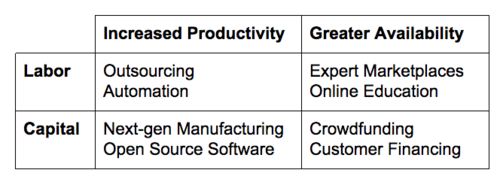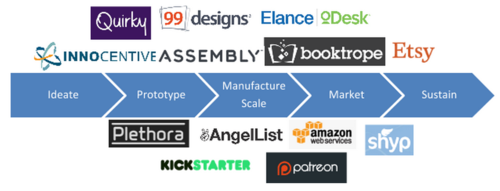Future of Work and Labor: Increasing Productivity Opens Myriad Opportunities
Last post I talked about macro trends that are shaping the future of work and labor. Over the next few posts, I’ll explore the trends’ ramifications and how they combine to induce greater economic shifts. This post focuses on increasing productivity opening new markets.
In the previous post, I highlighted how access to capital and labor are increasing while the costs of production - both transaction, fixed, and marginal costs - are decreasing. I’m going to quickly summarize those trends and then show how they enable teams to pursue new markets. I’ll use ‘lower costs’ and ‘increased productivity’ interchangeably; they mean that new platforms and technologies enable a given team to accomplish more with the same resources (workers or funding). Here is a quick summary of factors changing the productivity and availability of both labor (expertise) and capital (financing):

New platforms are driving these trends, making it cheaper and easier to prototype and scale. At every step of the process - from ideation to delivery - fewer resources are required and they’re easier to attain. This chart maps out the innovation process and some of the organizations that are making it easier:

The result is that an individual or small team can be insanely productive with little or no funding. It’s easy to prototype an idea and then scale if there is an audience. Fixed and marginal costs are getting closer to zero, enabling several significant trends.
Low Costs Open New Markets
As costs decrease, entrepreneurs can target smaller markets. When exploring a new opportunity, it’s important to know that there’s enough demand and potential profit to cover the initial expenses. Lower costs can make a product viable, even if it appeals to a tiny audience.
Decreasing cost structures will open up a wide variety of markets:
- Niche Interest - Targeting small groups of hobbyists
- Limited Duration - Only relevant for a short period, perhaps riding on a fad or temporary event
- Limited Geography - Catering to a localized audience
These three categories represent significant opportunities for entrepreneurs, even if they don’t have the same upside as larger markets. Large, established companies have greater costs - due to headcount, office space, and other overhead - which might prevent them from entering these smaller markets. Small teams can thrive in these niches and, if they want to scale beyond initial markets, there might be valuable adjacent markets which they can enter.
Low Cost Enable Crazy Experiments
Entrepreneurship is a process of experimentation and with that comes failure. As costs decrease, teams can run many more experiments for the same funding; as the availability of capital increase, more teams can form. This will likely increase the variability of ideas - there will be many more failures but we will also see more success: crazy ideas that never would have been tried if the costs were higher. This is especially valuable because it’s incredibly hard to guess which ideas are good before they’re tested (AirBnB is a recent example of this - when they started, most investors thought they were crazy).
At first, the high level of failure looks like it’s great for society but hard on the entrepreneurs; we benefit from the successes while they grapple with high odds of failure. I actually think this system works well for the entrepreneurs, too - the failures don’t cost as much and they learn valuable skills in the process. In the Bay Area, a failed startup usually results in a cushy job at Google or Facebook, where an entrepreneur can catch their breath until they’re ready for another ride on the startup rollercoaster.
###Consumer -> Maker -> Entrepreneur
A big benefit to lower costs is that amateurs and hobbyists can engage in production. I think it’s much more fun and meaningful to create than to consume. Cheap tools and free education make it easier than ever for consumers to begin tinkering. Once individuals are engaged in creative endeavors, it’s a short hop to entrepreneurship.
The ‘Maker’ culture has bloomed over the past decade as places like TechShop provide access to tools and educators while sites like Instructables have libraries of project ideas. On the web, accessible libraries and free hosting allow novice programmers to tinker on fun side projects and share them with the world. I strongly believe that everyone has the capacity to be creative; sometimes the barrier is just a lack easy tools or libraries of potential projects. For more on this topic, I recommend Clay Shirkey’s Cognitive Surplus.
As individuals shift from consumers to makers, they’ll have opportunities to make money from their hobby. This might be through consulting with their new skills or they might find that their project resonates with a broad audience and there’s an opportunity to commercialize it.
There’s a lot more to cover on the transition from Consumers to Entrepreneurs. Individuals making this jump will have different aims and needs than traditional startups. I’ll be dedicating a separate post to exploring this transition in depth.
Final Thoughts
This post focused on the positive impacts of the macro trends: greater participation in making, increased entrepreneurship, and niche audiences benefiting from targeted products and services. These trends also have negative ramifications, the text topic will cover how commoditization of labor impacts individual workers.